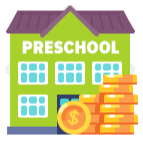While good elementary schools, high schools and colleges are important factors for parents to consider when choosing where to settle down, the availability of quality pre-K education is just as crucial. Children enrolled in early education programs are more likely to be academically prepared for future grades, as well as have higher graduation rates and higher earning potential than those who are not enrolled, according to the National Education Association. In addition, those who attend pre-K programs have been shown to have less risk of future crime than those who do not. Plus, one estimate shows that every dollar invested in early education programs for disadvantaged families may generate $7.30 in economic benefits due to its impact on helping children grow up to be healthier, higher-earning adults.
Despite the benefits of early education, only 11 states offer universal pre-K programs, though a growing number may implement it in the future.
To help parents find the states with the best early education systems, WalletHub compared the 50 states and the District of Columbia across 12 key metrics, including share of school districts that offer a state pre-K program, number of pre-K quality benchmarks met and total reported spending per child enrolled in pre-K.

Chip Lupo, WalletHub Analyst
Main Findings
States with the Best & Worst Early Education Systems
|
Overall Rank |
State |
Total Score |
Access Rank |
Quality Rank |
Resources & Economic Support Rank |
|---|---|---|---|---|---|
| 1 | Maryland | 77.62 | 14 | 2 | 5 |
| 2 | District of Columbia | 74.90 | 1 | 24 | 10 |
| 3 | Arkansas | 73.35 | 6 | 3 | 42 |
| 4 | New Jersey | 72.43 | 9 | 9 | 4 |
| 5 | New Mexico | 68.95 | 3 | 39 | 3 |
| 6 | Oregon | 67.98 | 13 | 20 | 1 |
| 7 | West Virginia | 67.80 | 8 | 9 | 19 |
| 8 | South Carolina | 65.22 | 18 | 5 | 33 |
| 9 | Vermont | 63.91 | 2 | 44 | 23 |
| 10 | Michigan | 63.88 | 20 | 7 | 14 |
| 11 | Connecticut | 63.01 | 21 | 4 | 40 |
| 12 | Rhode Island | 62.95 | 28 | 7 | 7 |
| 13 | Nebraska | 62.21 | 7 | 17 | 30 |
| 14 | Illinois | 58.43 | 5 | 42 | 26 |
| 15 | Kentucky | 56.93 | 19 | 18 | 27 |
| 16 | Oklahoma | 56.47 | 10 | 39 | 20 |
| 17 | Maine | 56.01 | 17 | 39 | 8 |
| 18 | Pennsylvania | 55.20 | 15 | 38 | 13 |
| 19 | Delaware | 54.94 | 30 | 21 | 9 |
| 20 | Louisiana | 54.62 | 22 | 16 | 36 |
| 21 | Iowa | 54.48 | 11 | 28 | 39 |
| 22 | Tennessee | 54.31 | 25 | 14 | 41 |
| 23 | Alabama | 53.65 | 16 | 31 | 22 |
| 24 | Washington | 53.34 | 23 | 29 | 16 |
| 25 | Wisconsin | 53.17 | 12 | 31 | 38 |
| 26 | South Dakota | 52.68 | 40 | 1 | 45 |
| 27 | Nevada | 52.63 | 31 | 15 | 29 |
| 28 | Arizona | 52.08 | 27 | 27 | 12 |
| 29 | California | 51.25 | 36 | 23 | 15 |
| 30 | Kansas | 50.87 | 4 | 51 | 37 |
| 31 | Virginia | 50.49 | 49 | 6 | 25 |
| 32 | Texas | 49.28 | 41 | 12 | 43 |
| 33 | Mississippi | 49.04 | 32 | 31 | 17 |
| 34 | Georgia | 48.09 | 47 | 13 | 28 |
| 35 | Colorado | 47.46 | 24 | 46 | 18 |
| 36 | Ohio | 47.11 | 29 | 25 | 44 |
| 37 | Utah | 46.85 | 39 | 22 | 34 |
| 38 | North Carolina | 46.02 | 48 | 9 | 35 |
| 39 | New York | 45.60 | 26 | 44 | 31 |
| 40 | Alaska | 45.37 | 35 | 48 | 2 |
| 41 | Florida | 43.88 | 42 | 19 | 49 |
| 42 | Indiana | 43.06 | 50 | 26 | 6 |
| 43 | Hawaii | 40.68 | 33 | 43 | 48 |
| 44 | Minnesota | 40.31 | 51 | 30 | 11 |
| 45 | Wyoming | 40.03 | 37 | 31 | 45 |
| 46 | North Dakota | 38.97 | 34 | 49 | 21 |
| 47 | Massachusetts | 38.16 | 46 | 47 | 24 |
| 48 | Idaho | 37.51 | 45 | 31 | 47 |
| 49 | Montana | 37.34 | 43 | 31 | 50 |
| 50 | New Hampshire | 36.49 | 43 | 31 | 51 |
| 51 | Missouri | 35.40 | 38 | 50 | 32 |
Note: With the exception of “Total Score,” all of the columns in the table above depict the relative rank of that state, where a rank of 1 represents the best conditions for that metric category.

- Highest
- 1. District of Columbia
- 2. Vermont
- 3. New Mexico
- 4. New York
- 5. New Jersey

- Lowest
- T-46. Montana
- T-46. New Hampshire
- 48. Hawaii
- 49. Utah
- 50. Nevada
- 51. Idaho

- Highest
- T-1. Connecticut
- T-1. Arizona
- T-1. Michigan
- T-1. North Carolina
- T-1. Maryland

- Lowest
- T-29. Alabama
- T-29. Alaska
- T-29. District of Columbia
- T-29. Florida
- T-29. Georgia

- Highest
- T-1. District of Columbia
- T-1. Oregon
- T-1. New Jersey
- T-1. Maryland
- T-1. California

- Lowest
- T-47. Idaho
- T-47. Montana
- T-47. New Hampshire
- T-47. South Dakota
- T-47. Wyoming

- Highest
- T-1. Oregon
- T-1. Alaska
- 3. Pennsylvania
- 4. Minnesota
- 5. Maine

- Lowest
- T-15. Arizona
- T-15. Arkansas
- T-15. California
- T-15. Colorado
- T-15. Delaware

- Highest
- T-1. Alabama
- T-1. Alaska
- T-1. Arkansas
- T-1. California
- T-1. Delaware

- Lowest
- T-44. Tennessee
- T-44. Wisconsin
- 49. Texas
- T-50. Kentucky
- T-50. North Carolina
In-Depth Look at the Places With the Best Early Education Systems
Maryland
Maryland is the state with the best early education system, in part because of recent increases in preschool enrollment for three-year-olds. Maryland had the 15th-highest increase in enrollment between the 2001-2002 and 2023-2024 school years, at 5%. It also has the 14th-highest enrollment overall for three-year-olds.
Another area where Maryland stands out is safety. In addition to having a statewide school safety plan, it also requires regular audits to make sure everything is in line.
Finally, Maryland has the fourth-highest spending per child enrolled in preschool, at $17,262 per year.
District of Columbia
The District of Columbia ranks second in the country for early childhood education, boasting the highest enrollment of three- and four-year-olds in pre-K, pre-K special education or Head Start programs. In the District, 84% of three-year-olds and 95% of four-year-olds are enrolled. Very few states have anywhere close to those numbers.
Enrollment is growing rapidly, too. D.C. saw a 62% increase in enrollment for three-year-olds and a 51% increase for four-year-olds between the 2001-2002 school year and 2023-2024 school year.
D.C. also spends the most money per child enrolled in preschool, at nearly $24,000 per year, giving children more resources and a better start to their education.
Arkansas
Arkansas ranks third for early childhood education. One contributing factor is that education is available to all, as parents do not have co-payment fees for child care. In addition, Arkansas spends over $10,000 per child enrolled in preschool each year, the 16th most in the country, which ensures that they have access to good quality early education.
Like most states, Arkansas has a robust school safety plan in place to keep children protected from harm, but it’s also one of only 17 states that require schools to be audited to make sure that they properly meet regulations.
To top things off, Arkansas has the fifth-highest share of three-year-olds enrolled in pre-K, pre-K special education or Head Start programs, and the 14th-highest share of four-year-olds.
Ask the Experts
Giving a child a good early education is something that can benefit them for their entire career as a student. For more insight into this vital developmental step, we consulted a panel of experts. Click on the experts below to read their bios and thoughts on the following key questions:
- What are the most important factors that influence a child’s educational development?
- Is education spending a direct measure of education quality?
- What can state and local policymakers do to improve their school systems without raising taxes?
- In evaluating the best and worst early education systems, what are the top 5 indicators?
Ask the Experts
Senior Associate Dean | College of Liberal Arts and Rapoport Centennial Professor | Department of Sociology - The University of Texas at Austin
Read More
Ph.D. – Director, Center for Evaluation & Education Policy; Professor of Education Policy, Indiana University
Read More
Professor of Economics, University of Texas at Austin
Read More
Professor of Education, Ashland University
Read More
Ph.D. – Associate Dean, College of Humanities & Social Sciences; Professor, Department of African & African American Studies, LSU Faculty Athletics Representative – Louisiana State University
Read More
Ph.D. – Professor, Early Childhood Education and Human Development, College of Education, Criminal Justice, and Human Services – University of Cincinnati
Read More
Methodology
In order to determine the best and worst states for early education systems, WalletHub compared the 50 states and the District of Columbia across three key dimensions, “Access,” “Quality” and “Resources & Economic Support.”
We evaluated those dimensions using 12 relevant metrics, which are listed below with their corresponding weights. Each metric was graded on a 100-point scale, with a score of 100 representing the highest quality of early education.
Finally, we determined each state and the District’s weighted average across all metrics to calculate its overall score and used the resulting scores to rank-order our sample.
Access – Total Points: 40
- Share of School Districts that Offer State Pre-K Program: Full Weight (~5.71 Points)
- Share of 3- and 4-year-olds Enrolled in State Pre-K Program: Double Weight (~11.43 Points)
- Share of 3- and 4-year-olds Enrolled in Pre-K, Pre-K Special Education and Head Start Programs: Full Weight (~5.71 Points)
- Presence of Waiting Lists or Frozen Intake for Child Care Assistance: Double Weight (~11.43 Points)
Note: Even if families are eligible for child care assistance, they may not necessarily receive it. Instead, their state may place eligible families on a waiting list or freeze intake (turn away eligible families without adding their names to a waiting list). Families may remain on the waiting list for a long time before receiving child care assistance, or may never receive it. - Pre-K Program Growth: Full Weight (~5.71 Points)
Quality – Total Points: 40
- Pre-K Quality Benchmarks Met: Full Weight (~10.00 Points)
Note: This metric considers the following benchmarks: 1) Early learning & development standards, 2) Curriculum supports, 3) Teacher has BA, 4) Specialized training in pre-K, 5) Assistant teacher has CDA or equivalent, 6) Staff professional development, 7) Class size 20 or lower, 8) Staff-child ratio 1:10 or better, 9) Vision, hearing, & health screening & referral, 10) Continuous quality improvement system. - Income Requirement for State Pre-K Eligibility: Full Weight (~10.00 Points)
- Requirement of School Safety Plans & Audits: Double Weight (~20.00 Points)
Note: This composite metric measures whether school safety plans or school safety audits are required in a state.
Resources & Economic Support – Total Points: 20
- Total Reported Spending per Child Enrolled in Preschool: Double Weight (~5.00 Points)
Note: Amount of all reported funds (local, state, and federal) spent per child participating in pre-K program. - Change in State Spending per Child Enrolled in Preschool: Triple Weight (~7.50 Points)
- Total State Head Start Program Spending per Child Enrolled in Preschool: Double Weight (~5.00 Points)
- Monthly Child Care Co-Payment Fees as Share of Family Income: Full Weight (~2.50 Points)
Note: Parent co-payments for a family of three with an income at 100 percent of poverty and one child in care.
Sources: Data used to create this ranking were collected as of July 1, 2025 from the National Institute for Early Education Research, Education Commission of the States and The National Women’s Law Center.








WalletHub experts are widely quoted. Contact our media team to schedule an interview.